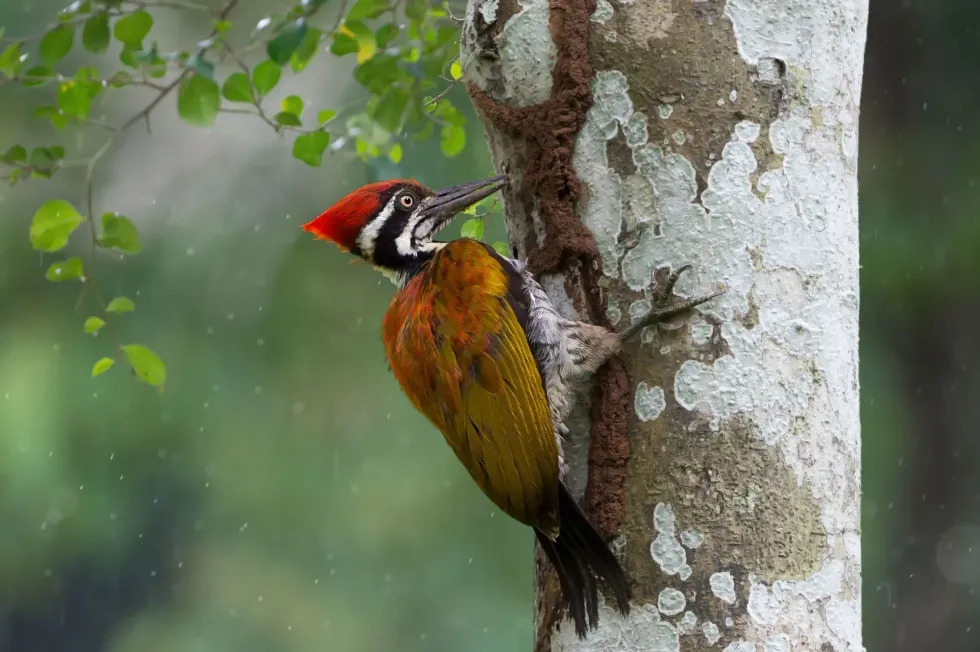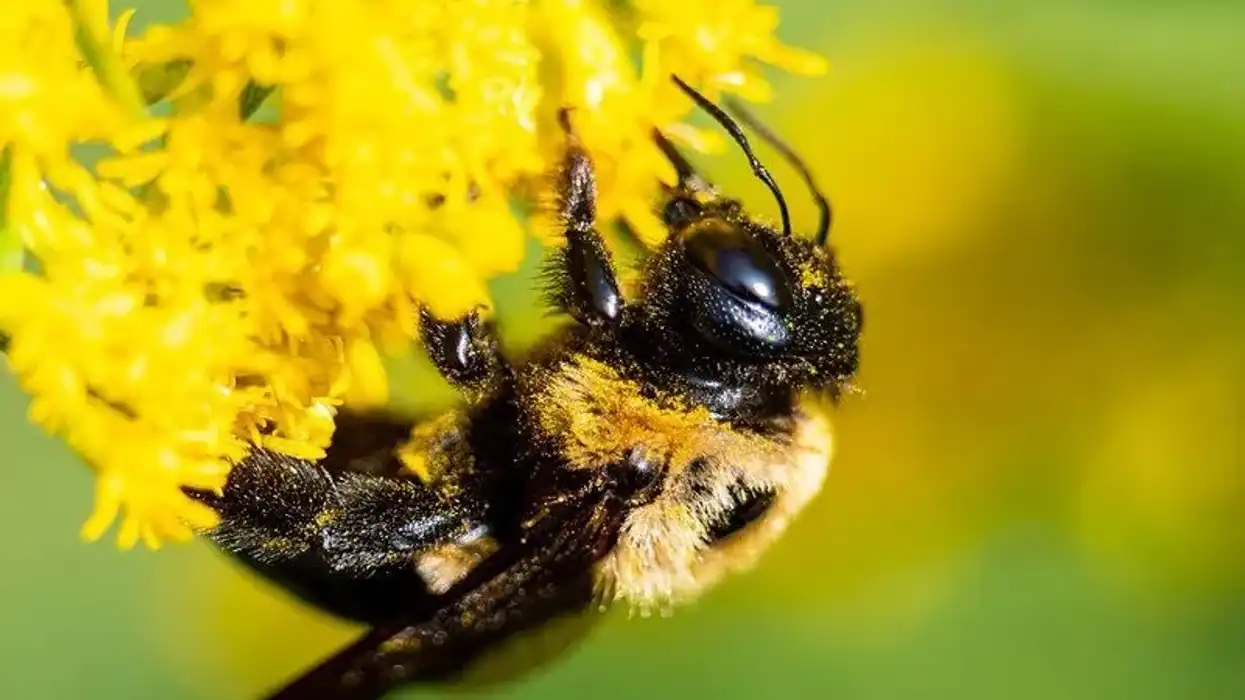The common flameback (Dinopium javanense), sometimes known as the common goldenback, is a species of bird in the Picidae family. Bangladesh, Brunei, Cambodia, China, India, Indonesia, Laos, Malaysia, Myanmar, Singapore, Thailand, and Vietnam are all home to it.
The spot-throated flameback is classified as a subspecies at times. A medium-sized, golden-backed woodpecker with long, solid black moustachial stripes.
The black eyes stripe is linked to the black rear neck stripe on both sexes. The male is crowned in red, while the female is crowned in black. They have a black tail that contrasts with their red rump and only three toes for identification.
Throat, face, and rump are rufous or buff in color. The black throat with delicate white markings instantly distinguishes it from other golden-backed woodpeckers in the Indian area.
The common flameback (Dinopium javanense) woodpecker is a big woodpecker. The contrasting brilliant plumage of this bird makes it a ray of sunlight among the branches and greenery.
For more great animal facts, check out these paddyfield warbler facts and North Island robin facts.
Common Flameback Interesting Facts
What type of animal is a common flameback?
The common flameback (Dinopium javanense), sometimes known as the common goldenback, is a species of bird in the Picidae family.
What class of animal does a common flameback belong to?
Common flameback (Dinopium javanense) is a bird belonging to the class Aves and Dinopium genus.
How many common flamebacks are there in the world?
The common flameback (Dinopium javanense) has distribution across the range and hence its exact number is unknown. Although habitat degradation may pose a hazard to this species, its predilection for open woods allows it to locate adequate nesting and feeding places.
Common flameback (Dinopium javanense) populations may be found across India at low altitudes up to around 3280.8 ft (1000 m).
Where does a common flameback live?
The common flameback (Dinopium javanense) prefers wet open forest and deciduous woods, as well as mangroves and scrub distribution. It prefers pine woods at higher elevations.
It is commonly found in agricultural regions, parks, and gardens, and is generally found in lowlands. Primarily found in moist tropical woods in two distinct regions: the Western Ghats of India and Southeast Asia.
What is a common flameback's habitat?
The black-rumped common flameback (Dinopium javanense) is a frequent resident breeder over most of South Asia. It is found mostly on the plains of Pakistan, India south of the Himalayas, and east to the western Assam valley and Meghalaya, Bangladesh, and Sri Lanka.
It is linked with open forests and agriculture. They are commonly observed in metropolitan areas with tree-lined avenues.
Who do common flameback live with?
The majority of woodpeckers live alone, however, there is a wide variety of behavior from very antisocial species that are hostile towards their own kind to species that dwell in groups. Woodpeckers are typically timid and will avoid other birds' nests, and not all species will invade another species' nests.
How long does a common flameback live?
A wild woodpecker's lifetime can range from four to twelve years, depending on the species. Larger woodpeckers have longer lifespans and can live up to 20-30 years under optimal conditions.
How do they reproduce?
The breeding season of common flameback (golden-backed woodpecker) varies with the weather and lasts from February to July. The birds generally excavate the nest hole, which has a horizontal entrance and descends into a hollow. Birds may sometimes take over the nest holes of other birds.
Mud embankments have also been found to hold nests. The eggs are deposited into a cavity that is not walled.
The usual clutch size is three eggs, which are elongate and glossy white. After around 11 days of breeding, the eggs hatch. After around 20 days, the chicks with red rump depart the nest.
What is their conservation status?
The common flameback (golden-backed woodpecker) is considered to be of Least Concern.
Common Flameback Fun Facts
What do common flameback look like?
The adult male golden-backed woodpecker has vibrantly colored plumage. Upperparts, rear neck, and upper mantel are black.
The remainder of the upper parts is olive with a golden wash and hence the name flameback. The feathers are yellow-edged, with an orange or red tint on the back and underparts are white.
The crimson bottom back and red rump are both brilliant. The upper tail-coverts are blackish-brown with olive undertones, and the tail is black.
The flying feathers have a dark brownish-brown color with white patches on the inner webs. The outer webs of secondary and tertial flying feathers are olive-yellow.
The crown and top of the head are red, while the forehead and upper lores are brownish-red in males. The crown is black with a thin black edge in females. A broad white stripe runs from the lores over the cheekbones and down to the neck and breast sides.
The chin and throat are creamy-white, with a line of tiny black dots running from the base of the bill to the lower throat. The bill is blackish with a lighter base, somewhat short and curled.
The eye of the flameback bird is a reddish-brown or brown, with a tight black ring around them. The three toes are gray or brown, with a greenish tint.
The female flameback is quite similar to the male, except she is duller. A red rump and a white neck distinguish it from the black-rumped flameback bird and helps in its identification.

How cute are they?
You might consider the common flameback (Dinopium javanense) cute.
How do they communicate?
Birds like the common flameback (Dinopium javanense) interact with one another through foraging song, call notes, and behavior. Birds utilize sound and activity to frighten off predators, like cats, bobcats, foxes, hawks, coyotes, and warn other birds of danger, attract a partner, and defend their territory. Its foraging call is a harsh rattling churrrrr.
How big is a common flameback?
Common flameback (Dinopium javanense) species is 11-12.6 in (28-32 cm) long.
How fast can a common flameback fly?
The common flameback (Dinopium javanense) flies in an undulating, rapid pattern.
How much does a common flameback weigh?
Common flameback (Dinopium javanense) typically weighs between 2.4-3.5 lb (1-1.5 kg).
What are the male and female names of the species?
Both male and female common flameback (Dinopium javanense) species are simply called male or female.
What would you call a baby common flameback?
They are called chicks. The juvenile species has the appearance of an adult. The breast is blackish-brown with white patches, while the underparts are darker. The eyes have turned a darker shade of gray. The juvenile male species has a black forehead, crown, and crest with a red crest, but the young female has pale stripes on the crown.
What do they eat?
This species is usually found in pairs or small groups, but it will occasionally join mixed-species foraging flocks. They go from the ground to the canopy to forage.
They eat insects, primarily ground beetle larvae, from beneath the bark, visit termite mounds, and occasionally dine on nectar. They frequently conceal themselves from possible predators by hopping among branches. They do well in human-modified environments, where they make use of manmade structures, falling fruits, and even food waste.
Are they dangerous?
Woodpeckers species, even the toughest of them, drill holes in wood. If you endanger their nests, they may feign an assault by flying towards you with great force.
While this is surprising and scary, the birds are unlikely to harm you.
In most situations, woodpecker damage to trees is not very damaging to the tree, but it can produce wounds through which diseases and insects can enter. In severe cases of woodpecker holes in trees, the tree trunk or branch may become girdled, resulting in the death of the region above the girdled bark.
Would they make a good pet?
It is against the law to keep woodpecker birds as pets. Woodpeckers are wild birds whose numbers are quickly diminishing. You may, however, aid in the care of a sick or injured woodpecker bird until it can be sent to a wild bird rehabilitation center.
Did you know...
In Sri Lanka, this woodpecker bird is known as kralaa in Sinhala. It is also known as kottoruwa in some sections of the island, however, it usually refers to barbets.
This bird appears on a Sri Lankan postal stamp worth 4.50 rupees. It's featured on a Bangladeshi postal stamp worth 3.75 taka.
Do common flameback migrate?
This bird is not known to migrate.
How many eggs do common flameback lay?
These birds choose an urban leisure area as their nesting site; its predators are just humans, and the odds of snakes ransacking/destroying their nest are quite low. Both partners, male and female, pursue each other through the woods during the courting displays.
The performances include crest-raising, bowing, and head-swinging. The male feeds the female during courting.
The common flameback (Dinopium javanense), like other woodpeckers, digs a nesting hole in a tree trunk, stump, or big limb. The hole is between 5-32.8 ft (1.5-10 m) above the earth, though generally less than 16.4 ft (5 m).
The nest is frequently excavated in a fruit tree or a coconut palm, as well as in an open location. The female lays two to three eggs.
Here at Kidadl, we have carefully created lots of interesting family-friendly animal facts for everyone to discover! For more relatable content, check out these frigate facts and secretary bird facts for kids.
You can even occupy yourself at home by coloring in one of our free printable common flameback coloring pages.










